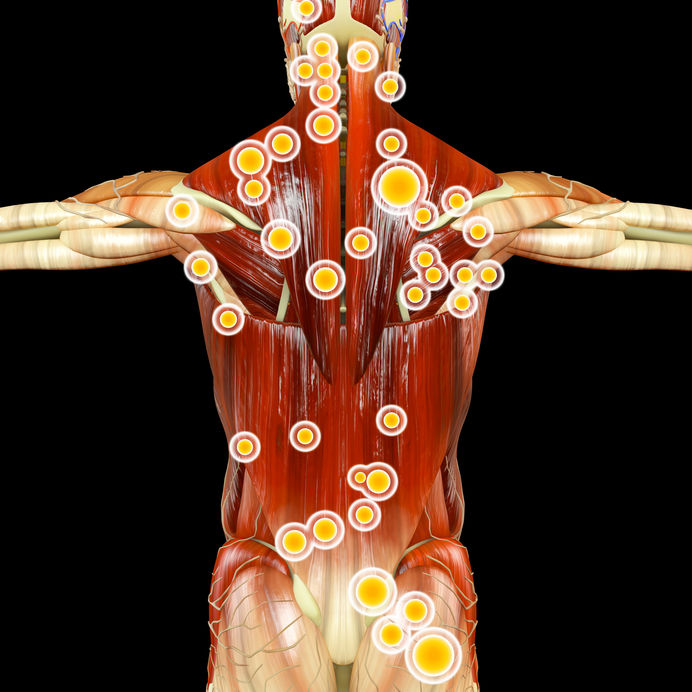Welcome to our blog! We’re excited to have you here. Today, we want to address a common question that many people have: Can massage therapists feel knots? It’s something that may have crossed your mind during a massage, and we’re here to provide you with some answers.
In our article, we’ll delve into the topic of how massage therapists are able to detect and work with knots in your muscles. We’ll explain how experienced therapists use their hands and senses to identify these areas of tension and discomfort. You’ll also learn about the various techniques and tools that can be used to effectively release these knots and provide relief. So, if you’ve ever wondered how massage therapists are able to find those pesky knots, stay tuned! We’ve got all the information you need.

This image is property of i.ytimg.com.
What are knots in muscles?
Definition of muscle knots
Muscle knots, also known as myofascial trigger points, are tight, sensitive areas that can form in muscles. These knots can vary in size and texture, and they are often felt as tender or painful spots in the muscle tissue. When you have a muscle knot, it may feel like a small, hard lump or a tight band of fibers under your skin. Muscle knots can develop from a variety of factors, including muscle overuse, tension, stress, or poor posture.
Causes of muscle knots
There are several factors that can contribute to the development of muscle knots. Overuse or repetitive movements can strain your muscles, causing them to become tight and form knots. Poor posture, whether it’s from sitting at a desk all day or slouching while standing, can also lead to muscle knots. Stress and tension can cause the muscles to tighten, and over time, this can result in the formation of knots. Additionally, muscle imbalances and certain medical conditions can increase the likelihood of developing muscle knots.
Can massage therapists feel knots?
Ability of massage therapists to feel knots
Massage therapists are trained professionals who have a strong understanding of the anatomy and physiology of the human body. They have the ability to feel and identify muscle knots through touch. By applying pressure and using their hands, massage therapists can palpate the muscles and locate areas of tension or tightness. They can feel the texture and density of the muscle tissue, allowing them to detect the presence of knots.
Techniques used to identify knots
Massage therapists use a variety of techniques to identify knots in your muscles. These may include static palpation, where they feel for areas of tension or tightness while your muscles are at rest. They may also use active palpation, which involves movement of the muscles to identify any restricted or painful areas. Additionally, massage therapists may use visual cues and ask you about any discomfort or pain you are experiencing to help pinpoint the location of the knots.
Signs and symptoms of knots
Physical sensations associated with knots
When you have muscle knots, you may experience a range of physical sensations. These can include localized pain or tenderness that may radiate to other areas of your body. The affected muscle may also feel tight or stiff, and you may notice a decrease in range of motion or flexibility. Muscle knots can cause muscle spasms, where the muscle involuntarily contracts and causes sharp or intense pain.
Common areas where knots occur
Muscle knots can occur in any muscle of the body, but they are more common in certain areas. Some of the most common areas where muscle knots occur include the neck and shoulders, upper back, lower back, and calves. These areas are often prone to tension and stress, and the muscles in these areas can become tight and develop knots more easily.
Benefits of detecting and treating knots
Improvement in muscle flexibility and range of motion
Detecting and treating muscle knots can have several benefits for your overall muscle health. By addressing knots, massage therapy can help to improve muscle flexibility and increase range of motion. Knots can restrict movement and lead to muscle imbalances, which can affect your posture and overall mobility. By releasing the tension and tightness associated with knots, massage therapy can help restore proper muscle function and allow for improved flexibility.
Relief from pain and discomfort
Muscle knots can be a source of chronic pain and discomfort. By addressing these knots through massage therapy, you can experience relief from pain and discomfort. The pressure and techniques used by massage therapists can help to break down the knots and reduce muscle tension. This can alleviate pain, reduce muscle spasms, and promote a sense of relaxation and well-being.

This image is property of kaizenhealthgroup.com.
Massage techniques for knots
Deep tissue massage
Deep tissue massage is a technique commonly used to target and address muscle knots. This type of massage involves applying firm pressure and slow strokes to reach deeper layers of muscle tissue. Deep tissue massage can help to release tension and break up adhesions in the muscles, including knots. It is important to communicate with your massage therapist during a deep tissue massage to ensure that the pressure is appropriate and comfortable for you.
Trigger point therapy
Trigger point therapy is another massage technique specifically focused on addressing muscle knots. This technique involves applying pressure to specific trigger points, which are areas of hypersensitivity in the muscle tissue. By applying sustained pressure to these trigger points, massage therapists can help to release the knots and alleviate pain and tension. Trigger point therapy may involve static pressure or may incorporate movement and stretching to further release the knots.
Tips to find a skilled massage therapist
Researching qualifications and certifications
When looking for a skilled massage therapist to address your muscle knots, it is important to research their qualifications and certifications. Ensure that they are licensed or certified in their field and that they have received proper training. Look for therapists who have experience working with muscle knots and specific techniques like deep tissue massage or trigger point therapy. You can often find this information on their website or by calling the massage therapy practice.
Reading client reviews
Reading client reviews can provide valuable insights into the skills and abilities of a massage therapist. Look for reviews that specifically mention the therapist’s ability to address muscle knots or provide relief from pain and discomfort. Pay attention to any feedback regarding communication, professionalism, and overall satisfaction with the massage therapy experience. This can help you make an informed decision when choosing a therapist.

This image is property of cdn-igjfl.nitrocdn.com.
How to communicate with massage therapists about knots?
Effectively describing your symptoms
When communicating with a massage therapist about your muscle knots, it is important to effectively describe your symptoms. Provide detailed information about the location of the knots, the type of pain or discomfort you are experiencing, and any other sensations or limitations you have noticed. Be honest and open about your expectations and desired outcomes from the massage therapy session. This will help the massage therapist tailor their techniques and approaches to address your specific needs.
Discussing expectations and desired outcomes
Having a discussion with your massage therapist about your expectations and desired outcomes is essential. Let them know if you are seeking relief from pain, improved range of motion, or overall relaxation. Share any concerns or questions you may have about the massage techniques they plan to use or any specific areas you would like them to focus on. Communication is key to ensure that you and your massage therapist are on the same page and working towards achieving your goals.
Preventing muscle knots
Maintaining good posture
Maintaining good posture is important for preventing muscle knots. Slouching or sitting in a hunched position can put strain on your muscles, leading to tension and the formation of knots. Be mindful of your posture throughout the day, whether you are sitting at a desk, standing, or engaging in physical activity. Use ergonomic supports or make adjustments to your workspace to promote good posture and reduce the risk of muscle knots.
Stretching and strengthening exercises
Regular stretching and strengthening exercises can help prevent muscle knots by promoting flexibility and muscle balance. Incorporate stretching into your daily routine, focusing on the muscles prone to knots, such as the neck, shoulders, and back. Engage in exercises that target the muscles you want to strengthen, as strong muscles are less likely to develop knots. Consult with a fitness professional or physical therapist to ensure you are using proper form and technique when performing these exercises.

This image is property of dynamicphysiotherapy.ca.
Alternative methods for relieving knots
Heat therapy
Heat therapy can be an effective alternative method for relieving muscle knots. Applying heat to the affected muscles can help increase blood flow and promote relaxation, which can aid in the release of knots. You can use heating pads, warm towels, or take a warm bath or shower to apply heat to the area. Be cautious not to use excessive heat or apply heat directly to the skin to avoid burns or injury.
Foam rolling
Foam rolling is a self-massage technique that can be used to relieve muscle knots. By using a foam roller, you can apply pressure to the knots and massage the surrounding muscle tissue. Foam rolling can help to release tension, increase blood flow, and promote muscle recovery. When foam rolling, start with gentle pressure and gradually increase intensity as tolerated. Focus on the areas where you feel knots or tightness, and spend extra time on those areas to help release the knots.
Conclusion
Seeking professional help from massage therapists is important when dealing with muscle knots. They have the ability to feel and identify knots through touch, and can use various techniques to address and alleviate them. By treating muscle knots, you can experience improved muscle flexibility, range of motion, and relief from pain and discomfort. Communicating effectively with your massage therapist about your symptoms, expectations, and desired outcomes is crucial for a successful massage therapy session. In addition to professional help, practicing self-care, maintaining good posture, and using alternative methods like heat therapy and foam rolling can also aid in the prevention and relief of muscle knots. Remember to take care of your muscles and seek professional help when needed to ensure your continued muscle health.

This image is property of bodyinmindinstitute.com.
